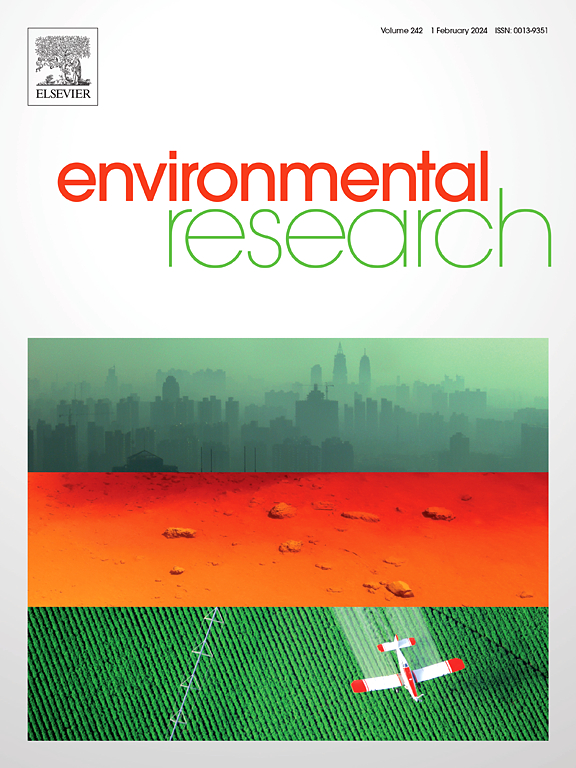氮空位介导的g-C3N4/BiVO4 Z-scheme异质结构纳米结构具有优异的光催化性能。
IF 7.7
2区 环境科学与生态学
Q1 ENVIRONMENTAL SCIENCES
引用次数: 0
摘要
本研究通过引入氮位(VN)和构建异质结,形成了一种新型的VN-g- c3n4 /BiVO4 (VN- cn /BVO) Z-scheme异质结光催化剂,该光催化剂在可见光下能有效降解代表性污染物罗丹明B (RhB),在30 min内对RhB的降解率达到98.91%。该光催化剂具有催化通配性,可降解亚甲基蓝(MB)。97.59%)和盐酸四环素(TCH, 76.89%)均可在100 min内获得。这种优异的性能归功于对氮空位和z -图式异质结的合理处理。在不同的环境条件(阳离子、阴离子和pH)下,考察了所制备的光催化剂在废水中的光催化降解TCH的性能,所合成的VN-CN/BVO光催化剂表现出优异的光催化性能和稳定性。通过液相色谱-质谱法进一步鉴定了TCH的分解产物,确定了合理的分解路线。本研究证明了VN-CN/BVO光催化剂对可见光下光催化降解有机污染物的重要性。z型异质结构和协同效应使体系具有高能量的载流子转移动力学和较强的氧还原能力。同时,表面氮缺陷作为电子受体加速界面电荷分离,并作为有机污染物分子的吸附活化位点,促进了非均相体系的高效传质。本研究为缺陷工程与异质结技术相结合的环境修复提供了新的思路。本文章由计算机程序翻译,如有差异,请以英文原文为准。

Nitrogen vacancy mediated g-C3N4/BiVO4 Z-scheme heterostructure nanostructures for exceptional photocatalytic performance
In this work, a novel VN-g-C3N4/BiVO4 (VN-CN/BVO) Z-scheme heterojunction photocatalyst was formed by introducing nitrogen vacancies (VN) and constructing heterojunction, which is able to efficiently degrade the representative contaminant rhodamine B (RhB) upon exposure to visible-light, resulting in an outstanding degradation rate of 98.91% of RhB within 30 min. This photocatalyst exhibits catalytic universality and allows the degradation of methylene blue (MB, 97.59%) and tetracycline hydrochloride (TCH, 76.89%) within 100 min. The exceptional performances are attributed to the rational manipulation of nitrogen vacancy and Z-scheme heterojunction. Furthermore, the performance of the prepared photocatalysts in wastewater was investigated by photocatalytic degradation of TCH under different environmental conditions (cationic, anionic, and pH), and the synthesized VN-CN/BVO photocatalysts exhibit excellent photocatalytic performance and stability. The decomposition products of TCH were further identified through liquid chromatography mass spectrometry and plausible decomposition routes were determined. This study demonstrates the importance of VN-CN/BVO photocatalysts for the degradation of organic pollutants by photocatalysis under visible light. The Z-scheme heterostructure and synergistic effects endow the system with high-energy carrier transfer kinetics and strong oxygen reduction capability. Meanwhile, the surface nitrogen defects serve as electron acceptors to accelerate interfacial charge separation and as adsorption activation sites for organic pollutant molecules, promoting efficient mass transfer in the non-homogeneous system. This work may provide new ideas for the combination of defect engineering and heterojunction tactic for environmental remediation.
求助全文
通过发布文献求助,成功后即可免费获取论文全文。
去求助
来源期刊

Environmental Research
环境科学-公共卫生、环境卫生与职业卫生
CiteScore
12.60
自引率
8.40%
发文量
2480
审稿时长
4.7 months
期刊介绍:
The Environmental Research journal presents a broad range of interdisciplinary research, focused on addressing worldwide environmental concerns and featuring innovative findings. Our publication strives to explore relevant anthropogenic issues across various environmental sectors, showcasing practical applications in real-life settings.
 求助内容:
求助内容: 应助结果提醒方式:
应助结果提醒方式:


